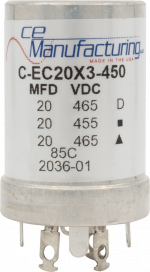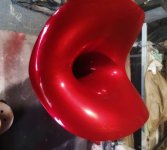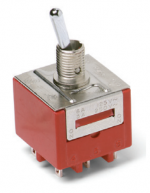7868s, with 6AN8s driving them. 12AX7s in the phono preamp stage.
The receiver works. It "tries" to play FM stereo - I can hear it - but the level is waaayy down from the mono selection and distorted. I'd like to fix that. I tested all 3 tubes in the multiplex section and they each - a 6AN8 and two 6AQ8s - test good.
Where else might I look for the 'ol plays in mono just fine, stereo giving only hints of being repairable?
Pulling the 6AN8 while operating leaves a faint mono signal, putting it back I can hear it separate into faint stereo on headphones. So that's what that tube does. Replacing it with a different tube makes no difference...
The receiver works. It "tries" to play FM stereo - I can hear it - but the level is waaayy down from the mono selection and distorted. I'd like to fix that. I tested all 3 tubes in the multiplex section and they each - a 6AN8 and two 6AQ8s - test good.
Where else might I look for the 'ol plays in mono just fine, stereo giving only hints of being repairable?
Pulling the 6AN8 while operating leaves a faint mono signal, putting it back I can hear it separate into faint stereo on headphones. So that's what that tube does. Replacing it with a different tube makes no difference...
Last edited:
Somebody must have tweaked on the multiplex transformers' alignment and got it messed up.
You may have to look for an old SAMS photofact manual for it. Those receivers sell for mucho dinero.
You may have to look for an old SAMS photofact manual for it. Those receivers sell for mucho dinero.
Last edited:
Long sleeve cycling jersey, jacket, bottle cage, gloves and seat pack at extra special pandemic shortage pricing. Bit the bullet after hearing that distributors warned the store even bikes might not be available for the 2022 season. Fun times.
Awesome score JJ. I would recommend you actually replace all of those coupling capacitors - I have significant experience with them (mostly not good) and they go leaky with old age and can result in cooked output tubes and potentially outputs and power transformer. (They may also be at the root of your MPX and other problems, check resistors too. It's rarely the tubes if it was put away in nice shape.)
Both JJ and FT make multi-sections cans that slip right into most Japanese equipment of this era without further modifications.
It's a really nice piece, you want to sort it out before use. Bringing it up unattended overnight on a variac is one way to end with a shorted power transformer, if you must do this place a ballast lamp (aka dim bulb) in series with the AC power lead.
Good luck!
Both JJ and FT make multi-sections cans that slip right into most Japanese equipment of this era without further modifications.
It's a really nice piece, you want to sort it out before use. Bringing it up unattended overnight on a variac is one way to end with a shorted power transformer, if you must do this place a ballast lamp (aka dim bulb) in series with the AC power lead.
Good luck!
I'm getting into 3D videography. So ...
A used JVC GS-TD1 3d camcorder from Japan plus new battery, 64GB SD card, microphone and Steadicam.
A used JVC GS-TD1 3d camcorder from Japan plus new battery, 64GB SD card, microphone and Steadicam.
Somebody must have tweaked on the multiplex transformers' alignment and got it messed up.
You may have to look for an old SAMS photofact manual for it. Those receivers sell for mucho dinero.
Or one of the carbon resistors has gone out of spec.
I sometimes wonder who wound up with my old Dynaco, Scott amps I donated to Goodwill in Tacoma 20 years ago…
If you can get that Pioneer working, you can likely sell it and have a decent bank account afterwards.
Today I tried a box of cinnamon apple Cheerios.
Ordered a Topping D90SE MQA DAC tonight so that I can fully decode MQA files from Tidal. (Roon does the first unfold, but I was curious what the fully decoded files sound like if at all different.)
The Topping DX-7S currently in the main system will get moved to my headphone system.
The Topping DX-7S currently in the main system will get moved to my headphone system.
end of life system, not dying but why wait
My final system now complete
. PassXP-32, X-150.8, XP-27, to go with the 60.8's bi-=amping a pair of Apogee Diva's. sounds so real. Thank You Nelson and Wayne
My final system now complete
. PassXP-32, X-150.8, XP-27, to go with the 60.8's bi-=amping a pair of Apogee Diva's. sounds so real. Thank You Nelson and Wayne
Member
Joined 2009
Paid Member
I bought some bits and pieces including old fashioned capacitors for clones of some Shindo gear that uses Mallory twistlocks. The new owners use the same equipment etc. and I'd rather use new than NOS given the age of the NOS stuff. I'll be using high reliability Japanese caps for the high stress post-rectifier positions.
Attachments
I just bought a pair of BNIB Sinclair IC10.
Early ic power amplifiers.
Over-rated by Sinclair as 10 watts but actually only 2 watts.
Will go nicely with my collection of Sinclair stuff.
Early ic power amplifiers.
Over-rated by Sinclair as 10 watts but actually only 2 watts.
Will go nicely with my collection of Sinclair stuff.
Finally turned loose some cash this week and ordered another pair of Etymotic in-ears to replace the ones that were stolen a few years ago. Man, I'd forgotten how good these things can sound.
I say "can sound" because, as hi-tech (and expensive!) as these things are, to my ear(s) they've always sounded surprisingly bad right out of the box. I wonder if anyone familiar can explain the reasoning for their target curve, because it's eluding me for sure. They begin by acknowledging that our ear canals resonate in the ~2K-4KHz region (mine are right at 2.5K). My understanding & personal experience has always been that our hearing is most sensitive in this region, in large part because of this resonance. But for some reason their method of counteracting this is to increase output in this range?! And sure enough, when I first try them on, that's exactly what I hear - WAY too hot in the upper midrange. I don't get it. 😕
The good news is how easy this is to fix. With both pairs I've owned (ER-4P, and now ER-4XR), all I've had to use is a standard 10-band, fixed-frequency low-Q equalizer, set to a downward-tilting curve of -1 dB/octave across the board (centered on 0 dB @ 1 KHz), with a couple of jiggles on the 2 lowest & highest bands to get the tonal balance just right. This immediately takes the sound from unlistenable to absolute magic. Easily the most detailed sound reproduction I've ever heard. (Granted I don't get out much, but still.) Even my tiny Sansa Clip-Zip (running Rockbox firmware, which provides the EQ) sounds wonderful.
The only remaining mystery is why this curve sounds so great, while the more logical approach of creating with the EQ a mirror image of the supplied response curve doesn't sound nearly as good, to me at least. But I'm not losing any sleep over this - just enjoying the amazing sound.
I say "can sound" because, as hi-tech (and expensive!) as these things are, to my ear(s) they've always sounded surprisingly bad right out of the box. I wonder if anyone familiar can explain the reasoning for their target curve, because it's eluding me for sure. They begin by acknowledging that our ear canals resonate in the ~2K-4KHz region (mine are right at 2.5K). My understanding & personal experience has always been that our hearing is most sensitive in this region, in large part because of this resonance. But for some reason their method of counteracting this is to increase output in this range?! And sure enough, when I first try them on, that's exactly what I hear - WAY too hot in the upper midrange. I don't get it. 😕
The good news is how easy this is to fix. With both pairs I've owned (ER-4P, and now ER-4XR), all I've had to use is a standard 10-band, fixed-frequency low-Q equalizer, set to a downward-tilting curve of -1 dB/octave across the board (centered on 0 dB @ 1 KHz), with a couple of jiggles on the 2 lowest & highest bands to get the tonal balance just right. This immediately takes the sound from unlistenable to absolute magic. Easily the most detailed sound reproduction I've ever heard. (Granted I don't get out much, but still.) Even my tiny Sansa Clip-Zip (running Rockbox firmware, which provides the EQ) sounds wonderful.
The only remaining mystery is why this curve sounds so great, while the more logical approach of creating with the EQ a mirror image of the supplied response curve doesn't sound nearly as good, to me at least. But I'm not losing any sleep over this - just enjoying the amazing sound.
C&K miniature DPDT toggle switches
Just bought 2 C&K miniature DPDT toggle switches (p/n 9221K1Z4QD) to switch from Triode to UL mode (cold switching, NOT when the amplifier is ON!). Definitely very expensive, but they can handle up to 10 Amps and have a dielectric strength of 2,500 Vrms min. @ sea level.
Regards, Gerrit
Just bought 2 C&K miniature DPDT toggle switches (p/n 9221K1Z4QD) to switch from Triode to UL mode (cold switching, NOT when the amplifier is ON!). Definitely very expensive, but they can handle up to 10 Amps and have a dielectric strength of 2,500 Vrms min. @ sea level.
Regards, Gerrit
Attachments
Last edited:
And I bought two bags of the kind of slide switches found in some synthesizers. One bag was a 2-pole-2-way and another a 2-pole 3-way, each containing 10 switches. I paid less for 20 switches than ONE spare switch for the Moog Concertmate MG-1 cost.
Of course they come from China.
Also ordered a lens cap for a lens, but made a mistake and ordered wrong size and the right size was out of stock.
Of course they come from China.
Also ordered a lens cap for a lens, but made a mistake and ordered wrong size and the right size was out of stock.
Decided to treat myself, and bought a pair of WH-1000XM4 headphones in black friday sales, which arrived today. I'm rarely impressed by a piece of tech but I have to say, I'm somewhat blown away by these so far.
Not really today - but haven't received or paid for them yet - so it much still count 😀
A pair of SB MW13TX-4 as midranges in my 4 way system, and a set of SB26ADC for at set of Augerpro waveguides that are currently being printed.
A pair of SB MW13TX-4 as midranges in my 4 way system, and a set of SB26ADC for at set of Augerpro waveguides that are currently being printed.
- Home
- Member Areas
- The Lounge
- And what did we buy today?


